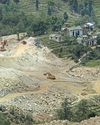
A RUPJYOTI SAIKIA is undoubtedly contemporary Assam’s finest historian and, by that measure, one of India’s most accomplished. He does not believe in half measures or over-reliance on the writings of others, no matter how reliable. He dives deep into archives and libraries, in Assam as well as in Delhi, London and Yale, scouring for evidence.
In The Quest for Modern Assam, Saikia does not disappoint. The book’s size and scope are daunting: it covers 58 years in more than 800 pages, of which 298 pages comprise bibliography, timeline and references, giving readers an understanding of the attention that he pays to detail. His major works have been focused on his home state of Assam where he is a professor of history at the Indian Institute of Technology, Guwahati.
Saikia brings a consistent scholarship to his telling of tales. He avoids jargon and the trademark haste of some of the new self-styled historians of the state and the region. His formidable tome acknowledges the challenges in writing "complex biographies of Indian states in the post-colonial period" and points out the need for the passage of time to reflect not just on events but also on the development of historical processes, trends and circumstances-political, economic and environmental.
This story is from the {{IssueName}} edition of {{MagazineName}}.
Start your 7-day Magzter GOLD free trial to access thousands of curated premium stories, and 9,000+ magazines and newspapers.
Already a subscriber ? Sign In
This story is from the {{IssueName}} edition of {{MagazineName}}.
Start your 7-day Magzter GOLD free trial to access thousands of curated premium stories, and 9,000+ magazines and newspapers.
Already a subscriber? Sign In

A SPRIG TO CARE FOR
Punarnava, a perennial herb, is easy to grow and has huge health benefits

DIGGING A DISASTER
Soapstone mining near Dabti Vijaypur village has caused many residents to migrate.

REVIEW THE TREATMENT
Several faecal sludge treatment plants in Uttar Pradesh suffer from design flaws that make the treatment process both expensive and inefficient

MAKE STEEL SUSTAINABLE
As India works to double its GDP by 2030, its steel industry must balance growth with sustainability. By embracing policies like the Steel Scrap Recycling Policy 2019 and adopting green technologies, India is paving the way for a more sustainable future in steel production

Can ANRF pull off the impossible for India?
Anusandhan National Research Foundation is expected to reorient India's innovation goals but funding issues, old mindsets remain a drag

TROUBLED WOODS
Forests are a great bulwark against climate change. But this is fast changing. AKSHIT SANGOMLA travels through some of the pristine patches of the Western Ghats to explore how natural disturbances triggered by global warming now threaten the forest health

BLINDING GLOW
The science is clear: increased illumination has damaging consequences for the health of humans, animals and plants. It’s time governments introduced policies to protect the natural darkness and improved the quality of outdoor lighting.

GROUND REALITY
What happens when the soil loses the ability to grow healthy, high-yield crops on its own?

GM POLICY MUST BE FARMER CENTRIC
On July 23, the Supreme Court of India directed the Union government to develop a national policy on genetically modified (GM) crops for research, cultivation, trade and commerce through public consultation.

Vinchurni's Gandhi
A 96-year-old farmer transforms barren land into a thriving forest in drought-prone region of Satara